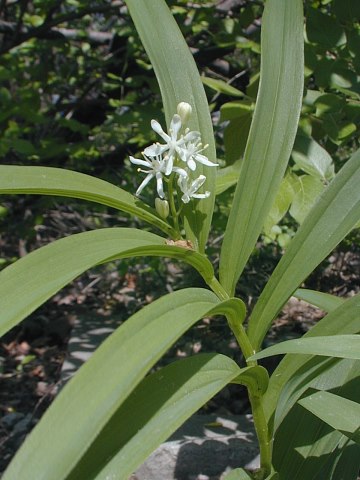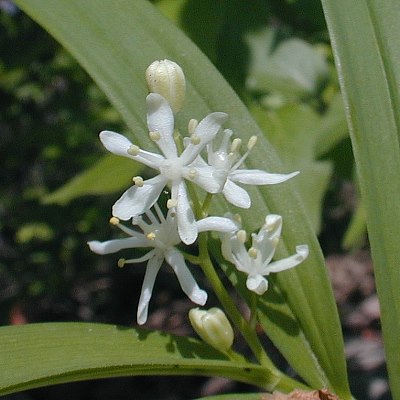Description: This herbaceous perennial plant is 1-2½' tall and unbranched. The central stem is stout, smooth, and zigzags slightly. It usually reclines to the side somewhat, rather than being held stiffly erect with respect to the ground. The alternate leaves are narrowly ovate, with parallel veins and smooth margins. They are up to 6" long and 2" across, and are sessile to the central stem, or have short petioles. The undersides of the leaves may be slightly pubescent.

The central stem
terminates in a single inflorescence consisting of small white flowers.
This inflorescence is a narrow raceme (almost spike-like) about 1-4"
long. Each flower has 6 narrow tepals, 6 stamens with yellow anthers,
and a central pistil that is shaped like a vase with a long, narrow
neck. When fully open, each star-like flower is about 1/3" across. The
blooming period occurs during late spring and lasts about 3 weeks.
There is a mild floral fragrance. Each flower is replaced by a small
berry about ¼" across. The berries are initially green with purple or
black stripes, but later become bright red. The root system consists of
stout rhizomes, which form vegetative colonies readily.
Cultivation:
This plant prefers moist to slightly dry conditions and partial
sunlight. It will also tolerate light shade and full sunlight. It is
not particular about soil texture, but often grows in sandy soil in
native habitats. Insects and disease are rarely bothersome.

Range &
Habitat:
Starry False Solomon's Seal occurs occasionally in northern and
east-central Illinois; it is uncommon to absent elsewhere within the
state (see Distribution
Map). This wildflower is native to Illinois.
Habitats
include sandy prairies, moist meadows in woodland areas, woodland
borders, sandy riverbanks and semi-wooded slopes, Black Oak savannas,
calcareous seeps, and the shrub zone of sand dunes near Lake Michigan.
Among the Smilacina spp. in Illinois, Starry False
Solomon's Seal is the most likely to occur in sunny areas, although it
usually doesn't stray far from areas with some woody vegetation.
Faunal Associations:
The flowers attract Halictid bees (including Green Metallic bees),
flower flies, and Tachinid flies primarily. These insects seek nectar
or pollen. The berries are eaten by woodland songbirds, including
various woodland thrushes and the Veery, as well as the White-Footed
Mouse. These animals help to distribute the seeds. Deer often feed on
the foilage, cropping the stems to about 6" above the ground.

Photographic
Location:
The photograph was taken near Busey Woods in Urbana, Illinois.
Comments:
Starry False Solomon's Seal has attractive foilage, flowers, and
berries. It can be distinguished from Smilacina racemosa
(False Solomon's Seal) by the narrower leaves and spike-like
inflorescence. The latter plant has a plume-like inflorescence that
consists of a spreading raceme. Another plant with similar foliage, Polygonatum
biflorum (Smooth Solomon's Seal), has broader leaves that are
pale green. However, the flowers of this species occur in pairs
underneath the leaves along the stem. Another scientific name for
Starry False Solomon's Seal is Maianthemum stellatum.